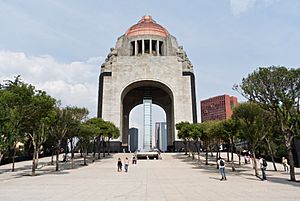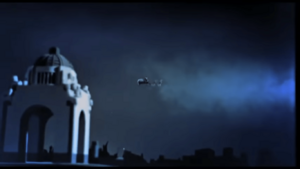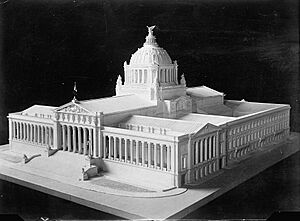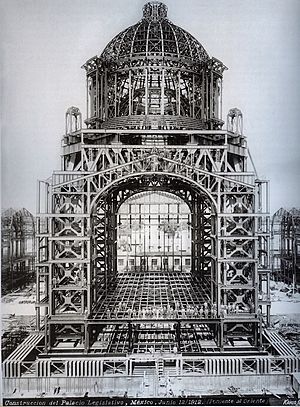Monumento a la Revolución facts for kids
Quick facts for kids Monument to the Revolution |
|
|---|---|
| Native name Spanish: Monumento a la Revolución |
|

West facade and museum entrance
|
|
| Type | Monument |
| Location | Cuauhtémoc borough, Mexico City, Mexico |
| Built | 1910 - 1938 |
| Architect | Émile Bénard Carlos Obregón Santacilia |
| Lua error in Module:Location_map at line 420: attempt to index field 'wikibase' (a nil value). | |
The Monument to the Revolution (Spanish: Monumento a la Revolución) is a very important landmark in Mexico City. It celebrates the Mexican Revolution, a major event in Mexico's history. You can find it in Plaza de la República, close to big roads like Paseo de la Reforma and Avenida de los Insurgentes in downtown Mexico City.
Contents
History of the Monument
The building was first planned as a grand government building called the Federal Legislative Palace. This was during the time when President Porfirio Díaz was in charge. He wanted it to be a huge symbol of his power and Mexico's progress. The building was meant to hold the meeting rooms for lawmakers.
However, the Mexican Revolution started, and the project could not be finished. This happened about 25 years later. A Mexican architect named Carlos Obregón Santacilia decided to turn the unfinished structure into a monument. It would honor the Mexican Revolution instead.
The Monument to the Revolution is now considered the tallest triumphal arch in the world. It stands 67 meters (220 feet) tall.
Building the Original Palace
President Porfirio Díaz chose a French architect, Émile Bénard, to design the original palace. The design was in a style called neoclassical, with French touches. This was to show that Mexico was a modern and advanced country.
Díaz placed the first stone in 1910. This was during celebrations for 100 years of Mexico's Independence. He also opened another famous monument, the Monument to Mexican Independence, at the same time. The inside of the building was made of iron. For the outside, fancy Italian marble and Norwegian granite were planned, instead of local Mexican stone.
Changes and Completion
President Díaz left power in May 1911. But the next president, Francisco I. Madero, kept the building project going. Sadly, Madero was killed in 1913, and the project stopped completely. It stayed unfinished for more than 20 years.
Finally, in 1938, during the presidency of Lázaro Cárdenas, the monument was completed. Architect Carlos Obregón Santacilia suggested turning the abandoned structure into a monument. It would honor the heroes of the Mexican Revolution.
Once his idea was approved, the building was changed. It combined styles like Art Deco and Mexican socialist realism. This was built over the existing dome structure of the old Federal Legislative Palace. A Mexican sculptor named Oliverio Martínez created four stone sculptures for the monument. Francisco Zúñiga was one of his helpers.
A Resting Place for Heroes

The Monument to the Revolution also serves as a mausoleum. This means it is a special burial place for some of the heroes of the 1910 Mexican Revolution.
These heroes include:
- Francisco I. Madero
- Francisco "Pancho" Villa
- Venustiano Carranza
- Plutarco Elías Calles
- Lázaro Cárdenas
However, one important revolutionary general, Emiliano Zapata, is not buried here. His family has chosen for him to remain buried in Cuautla, Morelos.
See also
 In Spanish: Monumento a la Revolución (México) para niños
In Spanish: Monumento a la Revolución (México) para niños



